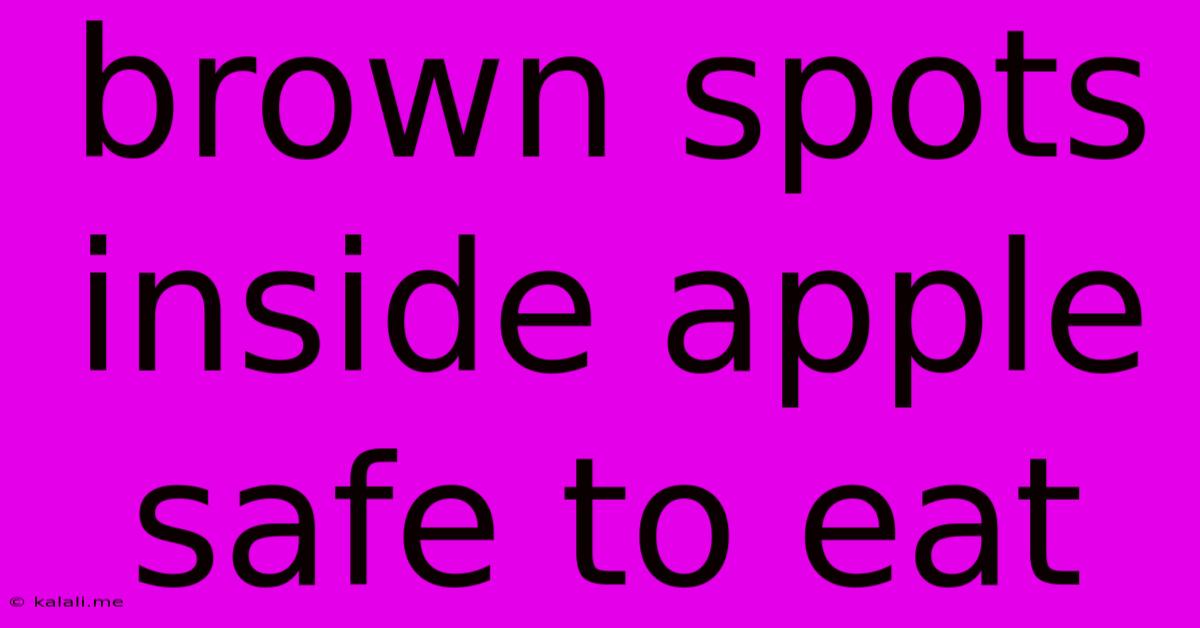Brown Spots Inside Apple Safe To Eat
Kalali
May 25, 2025 · 2 min read

Table of Contents
Brown Spots Inside Apples: Are They Safe to Eat?
Finding brown spots inside your perfectly good apple can be a bit disconcerting. Is it still safe to eat? This article will explore the causes of brown spots in apples, whether they pose a health risk, and how to determine if your apple is still suitable for consumption.
What Causes Brown Spots Inside Apples?
Brown spots inside apples are generally caused by enzymatic browning, a natural process that occurs when the apple's flesh is exposed to oxygen. This is often triggered by bruising during harvesting, transportation, or even just a bump in your fruit bowl. The enzymes within the apple react with oxygen, leading to the discoloration. This process doesn't necessarily indicate spoilage or the presence of harmful bacteria or fungi. The texture might also change, becoming slightly softer or mealy.
Other Potential Causes:
While enzymatic browning is the most common reason, other factors can contribute to brown spots:
- Freezing: If the apple has been frozen, the ice crystals can damage the cell structure, leading to browning upon thawing.
- Disease: In rare cases, brown spots could be a sign of a fungal or bacterial infection, although these would typically be accompanied by other symptoms like a foul odor or significant softening of the flesh.
- Pest Damage: Internal damage from insects can also cause browning, though this will usually be accompanied by visible signs of infestation.
Are Brown Spots Harmful?
In most cases, brown spots caused by enzymatic browning are perfectly safe to eat. The browning process doesn't create toxins, and the nutritional value of the apple remains largely unchanged. The taste might be slightly altered, but it generally won't be unpleasant.
When to Throw It Away:
While usually harmless, there are instances where it's best to discard the apple:
- Off-putting odor: If the apple smells sour, fermented, or otherwise unpleasant, it's likely spoiled and should be thrown away.
- Extensive browning and softening: If a significant portion of the apple is brown and mushy, it's probably best to discard it to avoid stomach upset.
- Visible mold: The presence of visible mold indicates decay and should be avoided.
Tips to Minimize Browning:
While you can't completely prevent enzymatic browning, you can take steps to minimize it:
- Handle apples gently: Avoid bruising during storage and transportation.
- Store properly: Store apples in a cool, dry place, ideally in a refrigerator.
- Use lemon juice: A quick dip in lemon juice can help slow down the browning process by reducing the effects of oxygen.
Conclusion:
In summary, those brown spots inside your apple are usually just the result of a natural process and are generally safe to eat. However, always rely on your senses. If the apple smells bad, looks significantly damaged, or shows signs of mold, it's best to err on the side of caution and throw it away. Otherwise, enjoy your slightly spotted, but still perfectly healthy, apple!
Latest Posts
Latest Posts
-
Does The Carpet Match The Drapes Meaning
May 25, 2025
-
What To Use To Condition Wood And Make It Smooth
May 25, 2025
-
Which Is Hotter Medium Or Mild
May 25, 2025
-
What Temperature To Season Cast Iron
May 25, 2025
-
How Far Can I Drive On A Spare Tire
May 25, 2025
Related Post
Thank you for visiting our website which covers about Brown Spots Inside Apple Safe To Eat . We hope the information provided has been useful to you. Feel free to contact us if you have any questions or need further assistance. See you next time and don't miss to bookmark.